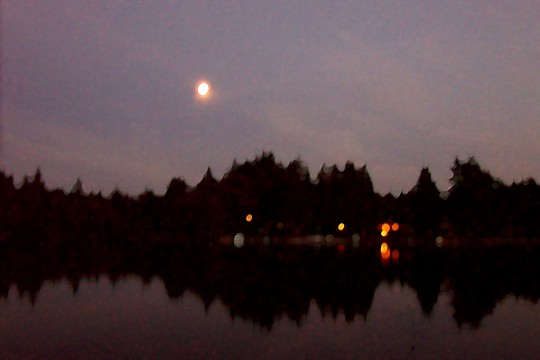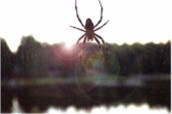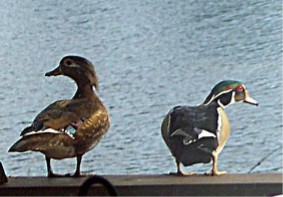Life at the Lake
a diary of living at a small lowland lakeWHAT IT'S LIKE

Early moonrise over Lake Ketchum
|
Archive Search |
| Links |
|
and s-integrator |
AUTUMN ALREADY?

Spider at my window—a portent of fall?
323
Do you feel it? I sure do. Autumn is in the air. Every year about this time I first feel it. (Perhaps I have special skin sensors, or antennae along my upper arms.) Or else (more likely) it is a certain slant of light perceptible in the morning. . . .
Anyway, things are decidedly changing. The filamentous yellow-green algae, with which the lake abounds in late spring and early summer, is gone: all bloomed out. It has died back and sunk toward the bottom of the lake. Meanwhile the duckweed has blossomed in profusion, and our pesticide applicator, Doug Dorling, arrived on Saturday and treated the lake with fluridone. If you have to use a herbicide on a living lake, this is probably the best one to use, for it becomes inert quickly (couple of days) and will not harm pets or fish. But it has a long-lasting effect and destroys ALL submerged vegetation.
For instance, the yellow water lily is pretty in modest amounts, and provides shelter for all kinds of fish, but bass and black crappie especially. After eight solid years of fluridone application to control elodea, Mexican water fern, and duckweed, we have no water lilies. It has been a gradual demise, and I and the fish miss them.
Along our shoreline abound spike rush, cinquefoil, long-leaved pondweed. This is because the State Department of Ecology wouldn't let us use our favorite herbicide on the lake until nearly a week ago. Normally we "treat": read poison) the lake a month ago, and don't have this profusion of "nuisance" weed. this late into the year. (Nuisance weed, you understand, is a minor version of weed deemed "noxious," which requires a whole different series of treatments and is considered by EPA to be a big, big problem. Luckily we are not under this dire classification.
This year we get to see what the lake looks like in unchecked evolution of its weed problem. It is not pretty, but it is natural, and to some of us not ugly, though it does tend to hamper swimmers. (Duckweed looks like trillions of tiny green clovers floating on the surface. And of course ducks love it. Already we have had visitations of hungry Northern Shovelers, but what will miss is the arrival of the American widgeon in large flocks in the fall, who will do their level best to rid of us of this tasty (to them only) weed.
Soon the duckweed will be gone. Fluridone will do the job again. And we may be rid of several types of algae, as well, but that is another story, one destined for another time.
- - Comments ()
...
WOOD DUCKS, ANYONE?

He (right) is no where to be seen, these days
322
But she is, with four ducklings in close attendance. They stream along our shoreline at mid-morning. My, how big they are; I'd say they are three-quarters her size. All have the characteristic female coloration. I suppose soon some of them will show the brilliant male coloration under the drab feathers. I know the blackbirds do this, and soon, as autumn approaches, we will see an orange hue under the shoulders of brindle juvenile red-winged blackbirds. It happens every year.
The mother takes up brief residence on our dock and looks on benignly as, one by one, the ducklings hop up onto the wood. The distance is about fifteen inches, and the first three make the hop easily. The fourth loiters and is slow to approach the dock. I soon see why.
He (it) hesitates, flexes his wings, his flight muscles, rears up on his haunches (or what corresponds to them), and declines the effort. He is lacking in confidence. This will take time. The mother pays what seems to be scant attention. But she is not missing a beat.
Number Four now begins to poke around the edges of the dock, oblivious to his seeming failure. He swims under it; well, I have seen them all do this. Shelter is shelter, for ducks, fish, frogs. And—one after another—his three brothers and sisters hop off the dock and join him in his pilgrimage. The mother is last.
They disappear under the foam flotation of the wooden dock and emerge on the other side, where they are greeted with spikerush, cinquefoil, and pondweed. It gives them good shelter.
Can they fly yet, I wonder? No clear sign, aside from the frequent rearing back and shouldering effort. Perhaps it will take some dire event to trigger this flight motion. I have seen them scoot for five or six meters along the top of the water, almost achieving the airborne condition. But not quite.
And, no, none of them have come to the porch feeder that contains their favorite mix of seeds. Not since spring and the start of the breeding season.
- - Comments ()
...